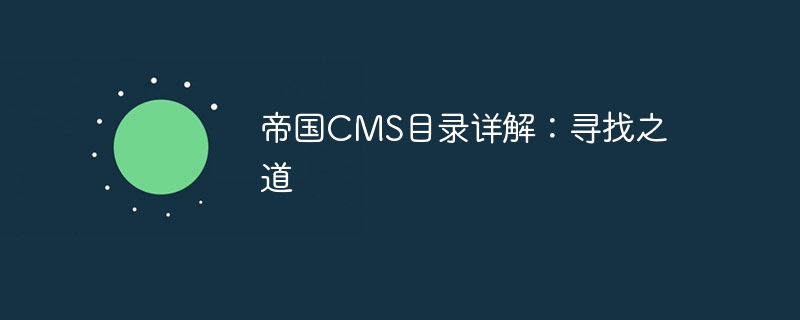Home >Backend Development >PHP Tutorial >Detailed explanation of the Imperial CMS directory: the way to find it
Detailed explanation of the Imperial CMS directory: the way to find it
- PHPzOriginal
- 2024-03-12 12:12:04989browse

Detailed explanation of the Empire CMS directory: the way to find it requires specific code examples
Introduction: As a powerful content management system, Empire CMS is used in website construction and management plays an important role in. Among them, directory management is a crucial part. This article will give you an in-depth understanding of the specific functions and operation methods of the Imperial CMS directory, and provide detailed code examples to help you better master the usage skills.
1. What is the Empire CMS directory?
Empire CMS directory refers to the categories in the website folder structure, which is used to facilitate the management and organization of website content. Each directory can contain multiple articles, pictures, files and other resources, which has an important impact on the overall structure and content display of the website.
2. Creation and setting of the Empire CMS directory
- Log in to the backend management system and find the "Column Management" option;
- Click "Add Column" and fill in the relevant Information, such as column name, keywords, description, etc.;
- Set the display method of the column, such as list display, picture and text display, etc.;
- Click the "Save" button to complete the creation and creation of the column. set up.
3. Editing and management of the Empire CMS directory
- Enter the directory management interface to edit and adjust the existing directory;
- Click on the directory Name enters the editing page, and you can modify the column name, keywords, description and other information;
- Add, delete or adjust the order and content of articles, pictures and other resources in the directory;
- You can set the directory Permissions to control the access and operation permissions of different users to the directory.
4. Batch operation and optimization of the Empire CMS directory
- You can adjust the information and settings of multiple directories at the same time through the batch operation function;
- You can optimize the website directory structure, adjust the associations and links between directories, and improve user experience and SEO effects;
- Understand and use the directory templates and code examples provided by Empire CMS to achieve a richer and more diverse directory display. style.
5. Code example: Custom directory template
The following is a simple code example that shows how to customize the display template of a directory:
{foreach $articles as $article}
<div class="article">
<h2>{$article.title}</h2>
<p>{$article.content}</p>
</div>
{/foreach}In In the above example, by traversing the article array, the title and content of each article are displayed. You can adjust the style and display method according to your needs.
6. Summary
Empire CMS directory management is an indispensable and important part of website construction. Through the introduction and examples of this article, I believe you will have a deeper understanding of the operation and optimization of Imperial CMS directory. understanding. In practical applications, combined with specific needs and code examples, you can flexibly use the directory function of Empire CMS to create more attractive and practical website content. I hope this article can provide you with useful help in Imperial CMS directory management, and I wish you greater success in website construction!
The above is the detailed content of Detailed explanation of the Imperial CMS directory: the way to find it. For more information, please follow other related articles on the PHP Chinese website!

